Disclosure: Meeple Mountain received a free copy of this product in exchange for an honest, unbiased review. This review is not intended to be an endorsement.
My friend Alec was walking into our game night, carrying a box that appeared large enough to be a pet carrier, a microwave, or one of those Bankers Box carriers used to move legal files.
It was none of those things. It was, in fact, the Anachrony Infinity Box, with so much Anachrony (2017, Mindclash Games) in the box that just seeing the box took my breath away.
About three hours later, I sat in my chair, exhausted. I am still amused that some people think Anachrony is “light.” Light is going to the beach, sitting there, looking out at the waves, listening to some good music, and reading a book that is so predictable that the liner notes give away the ending.
Anachrony is not that. As my colleague Ashley Gariepy mentioned all the way back in 2018 in one of our First Take Friday articles, “[Anachrony] is big.” Now that I’ve seen the box, everything in it, and all of the ways a game can play out, I can share this much:
I don’t think I’ll ever be good at it, but Anachrony is a good time. It’s a hell of a production, particularly the Infinity Box, but it also has the kind of world building fans have come to expect from the heavier titles in the Mindclash Games line.
It also has David Turczi.
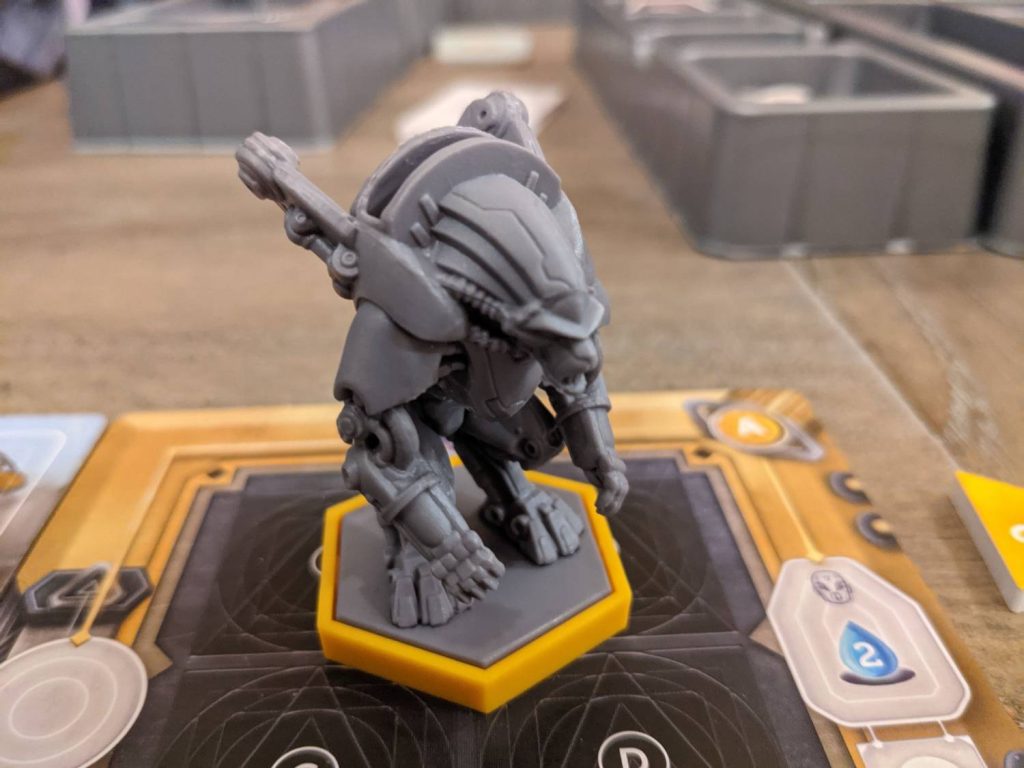
The Backstory
Usually, this is the point in a review where I trash a game because the world-building is weak, the theme feels pasted on, and/or the “characters” are a mix of White Guy with Blue Cap, White Guy with Red Cap, etc. and not factions with real issues.
Anachrony is not guilty of any of these. In fact, Anachrony is right there with some of the best games ever in terms of backstory, as evidenced by the 27-page art and storybook file referenced on the Mindclash website called Anachrony Art and Story Book.
But the Anachrony Art and Story book is rich. Most games don’t even take the time to tell you what’s really going on when playing the game, let alone why you might want to play. (Another Turczi design, Vengeance: Roll & Fight, doesn’t even tell players why their Hero is in trouble in the first place.) Anachrony is a world before you even rip off the shrink, then the gameplay leans into the desperation felt by each faction as they try to find a way to gather the resources needed to escape before a giant asteroid takes out their home planet.
Why does each faction know so much already? Because time travel has been invented, and people are using their new knowledge to get moving. In gameplay terms, you’ve got somewhere between 5-7 rounds to figure out how to get what you need to evacuate, and to gather enough points to become the ruler of whatever new planet you end up settling.
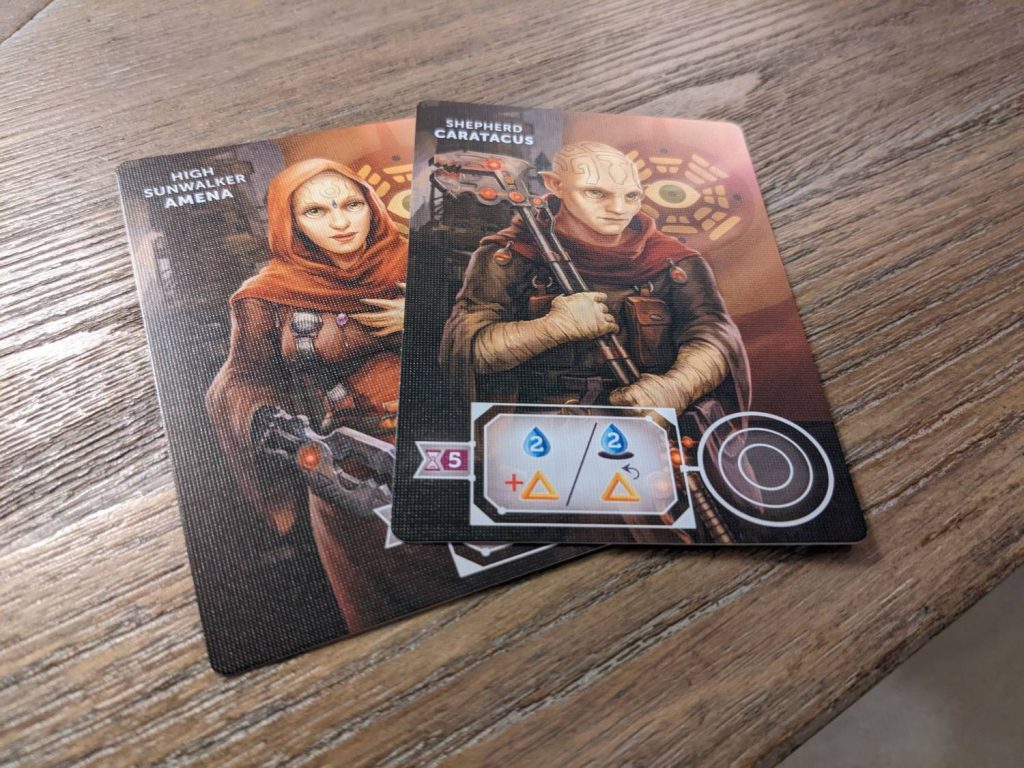
Then, Worker Placement!
Armed with a great, rich, well-illustrated backstory, you then need to place workers, gather resources, and score victory points.
But the mix of those workers is where the gameplay shines brightest for me. You’ve got two sets of places to go. First, your player board, where you will send workers like Engineers, Geniuses and Scientists to activate buildings. Standard fare.
But you’ll also need to send workers out to the main board in Exosuits to perform better tasks—like building those buildings, or hiring more workers. But to even power up the suits, it’s going to cost you (maybe resources, maybe power cores). And to use workers, it’s also going to cost you, usually in the form of water to wake up anyone who worked hard enough the day before.
What makes Anachrony such a heavy piece of chicken for me is that it feels like you’ll have a lot of time to do the things you want—not even to build a strategy necessarily, but just to feel like you are doing useful things from turn to turn.
But then the game really lays it out for you because of the time travel element: you already don’t have much time to execute that strategy, AND you’ll sometimes need workers to go back in time to repay loans you’ve given yourself in previous rounds.
Uhh, what?
So, to recap: you need workers for the main board, your player board, and to really make the most of things, you need workers to go back in time using some of the buildings on your player board. Plus, you’ll need to constantly math out how many workers you’ll need in a round to maximize the efficiency puzzle.
A first turn in Anachrony really hurts the brain. For some, that will be why you buy a game like Anachrony in the first place. For others, it’s the reason why you just stopped reading this review.
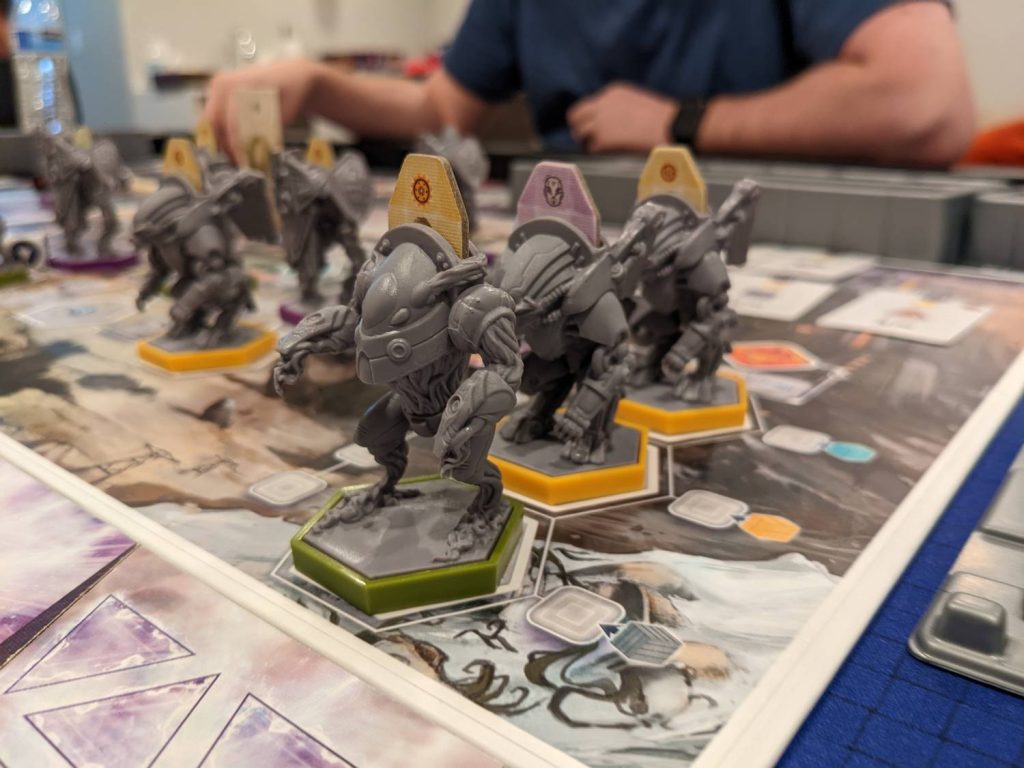
Symbiotic
If you’re still here, I think it’s because you want to make sure that I see what many Anachrony veterans see: it’s quite a rich puzzle, a puzzle that is worth playing even with the peasant version of the game.
Let’s pause to talk about the production.
The game’s standard version, Anachrony Essential Edition, is a perfectly fine production. But I had the chance to see the Infinity Box version of the game, with Exosuits in the form of incredible plastic minis that hold each worker in place with a look that makes it feel like they are operating an actual suit.
The resources were metal, the storage solution has the look of Game Trayz, and for some reason the crazy height of the box makes everyone ask about it when it’s on a friend’s shelf. It is deluxe in every way games can be deluxe.
Back to that puzzle: it’s rich. It’s rich because spaces are so tight, particularly in the areas that create the most conflict: Construct (for building buildings, which fill up your player board and offer more worker placement spaces) and Recruit (for bringing in workers from the market). In a three-player game, those spaces feel really tight, especially if you are behind the proverbial eight-ball in turn order.
Wow, turn order is so huge in Anachrony!!
Going last in a game, any game with limited spaces, actions or resources, is always a challenge, but in some games (Origins: First Builders comes to mind here), you can get around it. In Anachrony, it will cost you the game, particularly late in a game where players are pushing to achieve their personal goals to escape the dying planet before an asteroid wipes out everything.
I like the tension that comes from deciding whether to spend the resources needed to take the first player banner in a round; eventually, you’ll have to do it if you are last in turn order, because placement spots are so tight.
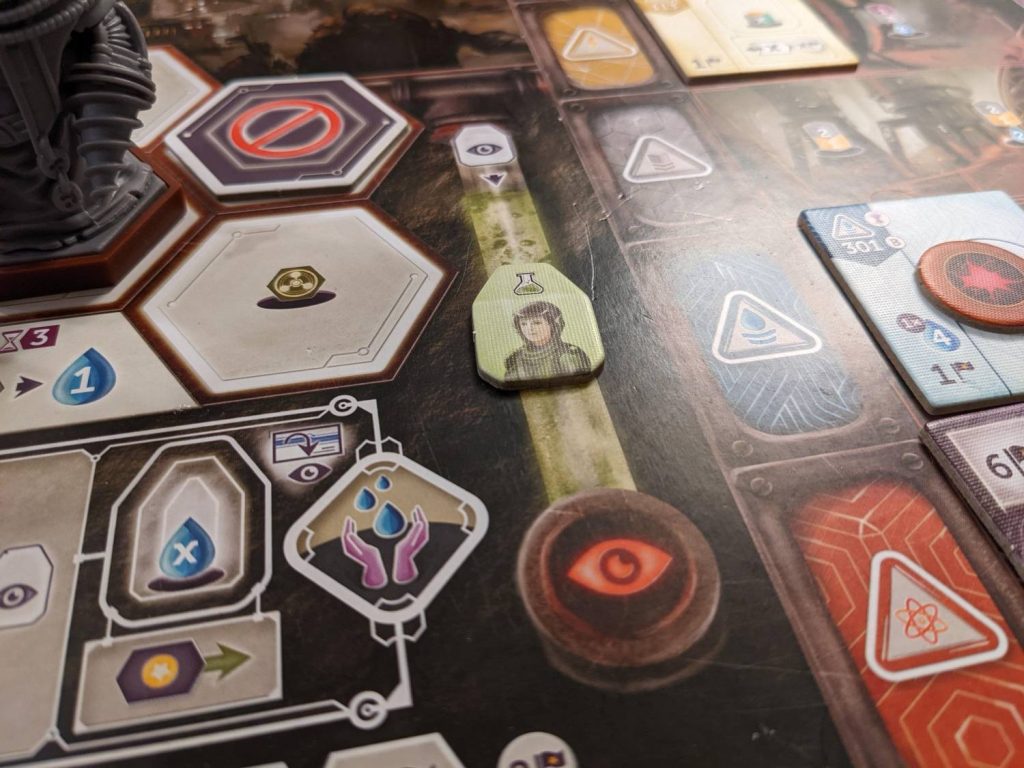
Is Anachrony Too Tight?
That’s the question I asked after my first play of the game. I feel better about it now, but there’s no question that the experience is tense because you usually don’t have a ton of every resource you’ll need over the course of a game.
Sometimes, you’ll have enough resources to build a building, followed by maybe another in quick succession. Since every player’s resources are public, you’ll be able to track when your neighbor is about to jump on a Superproject (one of these opens up in each round, known as Eras, and Superprojects always cost a bunch of resources and Research tokens to build) or when they can potentially take away a building you want to build first.
Adding to the tension around resources are the sheer number of things you’ll need to think about each turn. Forget the remaining worker spaces for a moment; do you even have enough water to wake up the workers you need that round to do what you want? Do you have the resources to power up all six of your Exosuits in a round, instead of just three or four? You’ve got an Exosuit to gather resources, but if you send an Engineer, that Engineer will remain active for the next round of the game.
Did you just realize that you are out of Engineers??
Scoring in Anachrony is always going to be low, so everything can be a grind for a new player. Plus, you’ve got some public scoring milestones, five of them, to worry about each game as well. All of them seem like they will be worthless—scoring only a couple of points each—but if one player scores them all, they will run away with the game.
So, to reiterate: Anachrony is tight.
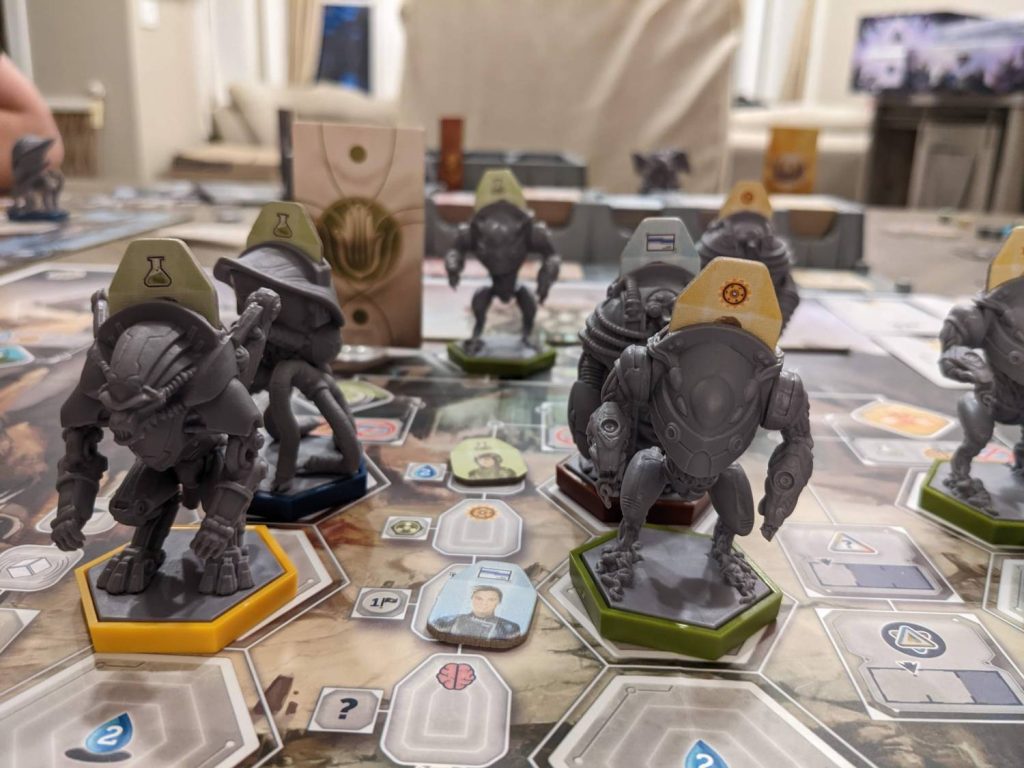
But, It’s My Kind of Tight
Anachrony is a thinky affair, a game rich with theme and backstory, and rewarding gameplay if a player can execute on their strategy.
It’s a game I have never won, and I’ll almost certainly struggle to win because of the investment required to get better at it. But that’s OK; that just means the challenge is there for those willing to get the plays in.
The Essential Edition is fine, but at a minimum, players should buy the Exosuit Miniatures Set to replace the Essential Edition’s plain cardboard tokens. (I did just that at SPIEL ‘22.) Slipping a worker inside the miniatures is something else, an incredibly slick mechanic that makes it really feel like you are sending a Genius out into a dangerous world to hire another worker or trade with nomads to get more resources.
Depending on your gaming circles, I do think Anachrony struggles most with accessibility; getting this to a table with a mixed crowd of gamers—particularly those not willing to sit through a teach that could take as much as an hour—is really challenging, and like many other heavy strategic gaming experiences, Anachrony strongly favors those most familiar with the game.
If you can clear these hurdles, Anachrony is an easy recommendation for any gamer looking for a brain burner in a sci-fi setting.



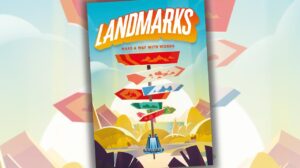

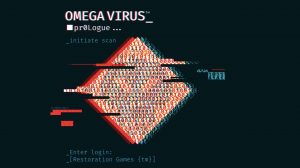





Add Comment